Living in London – 16 Top Tips to Life in the Capital

Say hello to London, an iconic and vibrant city that promises an exciting adventure at every turn, living in London is almost a rite of passage for many in the UK.
Moving to a new city, especially one as extensive as the UK’s sprawling capital, might initially seem overwhelming.
However, London’s unique charm and various benefits will soon make it feel like home.
The city caters to everyone’s needs, boasting world-renowned universities for students, a range of career opportunities for young professionals, and a rich tapestry of excellent things to do for residents of all ages.
From iconic landmarks and cultural festivals to serene parks and eclectic neighbourhoods, there’s never a dull moment for those who have already made their dream of living in London a reality.
If you are considering living in London, to make your transition smoother, we’ve compiled a list of 21 top tips to help you navigate and embrace life in this magnificent city.
Whether you’re searching for the perfect home, exploring London’s hidden gems, or simply trying to feel at home amidst the hustle and bustle, our guide aims to light the way.
So, let go of any apprehensions and prepare to embark on an extraordinary adventure. London is not just a place to live; it’s a place to thrive.
Cost of Renting a Home
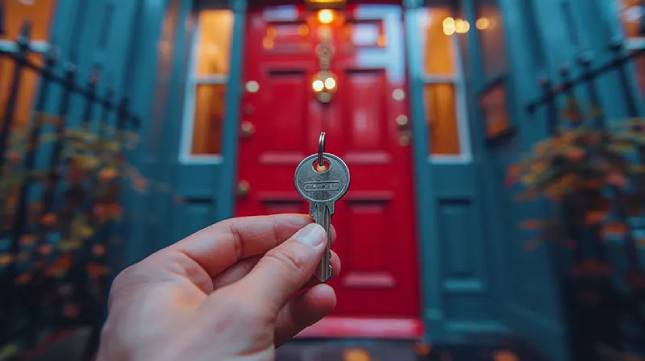
Renting a property in London is a great way to get a taste for what living in the city is like.
Moving to London can be an incredibly rewarding experience, and finding the right somewhere to call home is a crucial part of that journey.
Though challenging, you can secure a great place to live with careful planning and patience.
Also, you must bear in mind that the market moves fast, according to London Loves Property, London’s rent prices have jumped by +1.5% in one month alone, which is around £32pcm more for the average renter in the region.
It’s common for Londoners to spend at least half of their monthly salary on rent.
Depending on the area, the average cost of renting a one-bedroom property ranges from £1,400 to £2,000.
If you work in Central London and want to be near your office and its famed nightlife, expect to pay around £2,400 for a one-bedroom apartment.
Families might find it more challenging as they will need larger spaces, typically found further from the city centre.
Renting in areas like the South of the Thames or the East End tends to be more affordable, with the Borough of Redbridge averaging approximately £1,707 a month.
For more tips on renting in London, check out London in Real Life.
They have 13 steps for first-time renters in London.
Cost of Buying a Home
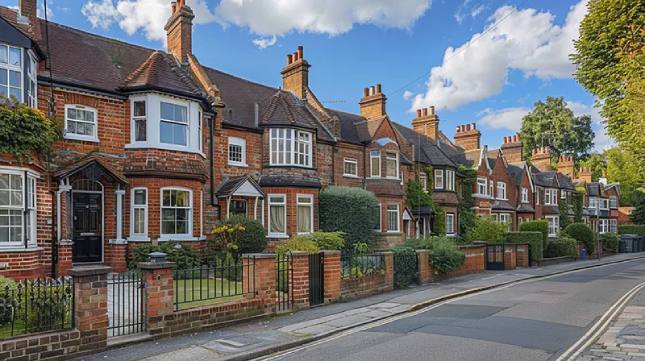
House prices in London are unsurprisingly the highest in the UK.
Renting a home in London can be excessive but manageable if you’re willing to compromise on location.
The 32 boroughs of London cover a vast area, with property prices varying significantly.
The market is competitive, and sometimes a cheeky offer might work in your favour.
For example, Barking offers some of the cheapest properties, starting at around £240,000 for a flat, while a semi-detached house costs an average of £420,000.
In contrast, affluent areas like Chelsea and Kensington can command prices upward of £2 million.
Renovation projects are also popular, with rundown buildings offering the potential for huge profits if you’re willing to invest the time and money.
The capital has hundreds of unloved homes waiting to be updated. London’s property market is dynamic, with prices varying even within close proximity.
For accurate and up-to-date property prices, Zoopla is a reliable source.
Best Places to Live in London
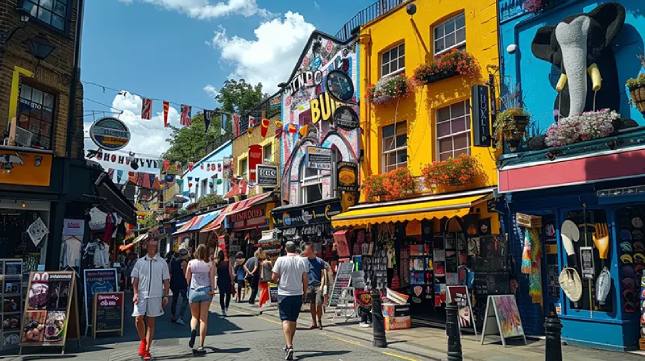
London is home to a variety of amazing places to live, the best choice for you will depend on your specific requirements.
London is full of great places to settle.
Choosing where to live in London depends largely on your circumstances, preferences and budget.
However, there is sure to be an ideal place for you.
Young professionals might prefer to live closer to the city centre for an easier commute, while families often seek areas with good schools and more green spaces.
Here is a selection of areas to consider:
Camden
This ever-trendy neighbourhood is known for its artistic flair and live music venues, offering a truly unique living experience close to St Pancras station.
North Greenwich
North Greenwich is an up-and-coming area to consider when moving to London. The once desolate peninsular now boasts a choice of new high-rise apartments and a growing number of shops and restaurants.
There are also some excellent transport links into central London, plus residents have easy access to one of the capital’s best entertainment venues, the O2.
Putney
Putney, situated on the River Thames in Southwest London, offers residents a more relaxed environment with beautiful parks, such as Richmond Park, right on your doorstep.
This is a great location for those who enjoy a more community-based community without moving further out into the suburbs.
Chelsea
Chelsea is one of the most expensive and prestigious areas for those seeking the luxury often associated with the capital.
The area is home to many celebrities and top-rated schools and provides some of the best amenities and transport links across the whole of London.
Hammersmith
Hammersmith, a middle-class riverside district, provides easy access to both Heathrow Airport and Central London, making it an ideal location for commuters, young professionals and families.
This broad appeal makes Hammersmith a very diverse area, plus there are plenty of great restaurants and venues here, ensuring there is always something to do!
To explore these and other London neighbourhoods, visit MoveHub.
Cheapest Places to Live
Despite its reputation for high costs, London has pockets where property prices are more affordable.
Areas like Acton, connected to the Central Line, offer homes from £175,000 for a one-bedroom flat.
Kentish Town is in the same borough as Camden but less expensive.
This popular area is known for its pubs and bars, and property prices here start at £330,000.
Barking and Dagenham are arguably the cheapest, with an average home cost of just over £363,936.
Ilford is also set to benefit from better travel links and offers a range of new-build flats and period properties.
Properties here start from £185,000.
As with many locations across London, some of these areas are poised for huge levels of growth.
The capital is always evolving and these ‘cheaper’ areas often attract huge levels of investment, making them attractive places to consider buying a home.
Expensive Places to Live in London
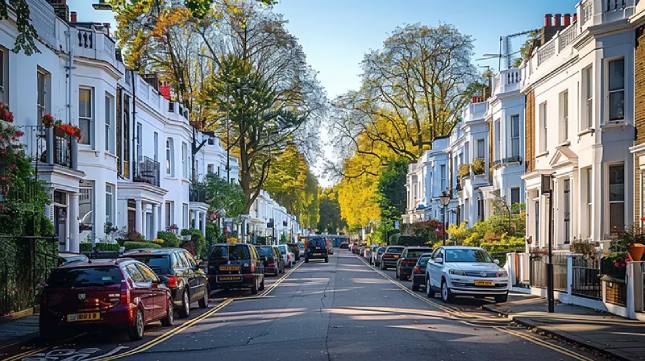
Kensington is one of the most desirable locations to live in London.
If budget is no concern, London offers some of the most luxurious real estate in the world.
Kensington, home to celebrities and affluent individuals, provides a community village feel within the heart of the capital.
Average home prices in the area are £2,401,572.
Knightsbridge, known for its luxury shopping at Harrods and Harvey Nichols, also features high-end residential properties starting at £2.1 million for a luxury apartment.
Chelsea, with its artistic and bohemian reputation, offers 4-bed Georgian and Victorian terraced houses overlooking beautiful garden squares, with prices starting from £1.8 million.
These areas provide lavish homes packed with high-tech gadgets, indoor swimming pools, and more, appealing to those seeking a premium lifestyle.
For luxury property listings, visit Sotheby’s Realty.
Cost of Living
It is no secret that living in London comes with a high cost of living, but there are ways to manage expenses.
Shopping at local markets or budget supermarkets like Lidl and Aldi can save you money compared to upscale stores like John Lewis or Waitrose.
According to Numbeo, the cost of living calculator, here are some common everyday food items and what you are likely to pay for them in London:
Average grocery prices in 2024 include:
- £1.13 for a litre of milk
- £1.59 for a loaf of bread
- £3.64 for a regular cappuccino
- £3.12 for 12 eggs
- £1.29 for a Kilo of Potatoes
- £9.50 for a mid-range bottle of wine
- £80 for a mid-range restaurant meal for two people
Entertainment does not need to break the bank either, as many attractions, such as the Natural History Museum and the British Museum, are free.
Visit London has a list of 101 free things you can do in London!
A monthly travel ticket covering buses and trains costs around £200, and using an Oyster Card for pay-as-you-go travel can help manage expenses.
While the initial cost of living in London might seem high, higher salaries in the city often balance these expenses.
Places to Shop in London
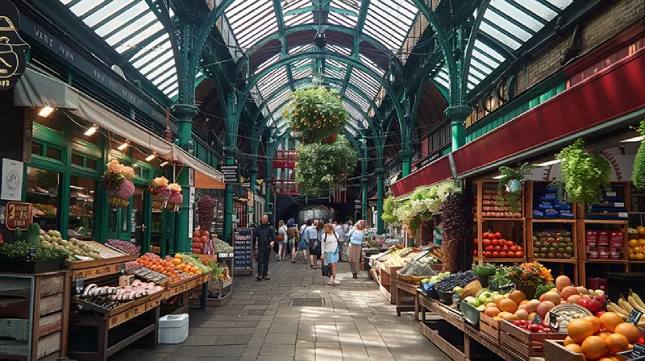
There are some amazing shopping locations across the capital.
London offers some of the best shopping locations in the world.
Here’s our roundup of the best places to go shopping in London; whether it’s a larger shopping centre with a range of options or a winding cobbled back street packed with one of shops, London is renowned for its diverse shopping experiences:
Covent Garden
This famous area is a vibrant hub close to Charing Cross bursting with unique shops, cafes, and the famous Apple Market, ideal for lovers of one offs and artistic items.
Borough Market
Over 1,000 years old, Borough Market is a food lover’s paradise, offering a wide array of local and international cuisine.
Camden Market
Camden Market is known for its eclectic mix of stalls selling everything you could ever imagine, from handmade clothes to gorgeous jewellery. While exploring the market there are also various street food stalls so be sure to enjoy some cuisine from around the world.
Oxford Street, Bond Street, and Regent Street
Perhaps the most famous shopping region in London, these bustling streets are never dull as people from across the globe flock here to enjoy the range of retail options.
The streets are home to designer stores like Gucci and Burberry, while Harrods and Fortnum & Mason offer luxury goods and foods.
Westfield
There are in fact two of these very popular shopping centres in that capital, one in West London and the newer sister site in Stratford. These huge ‘malls’ provide shoppers with over 265 different retailers, offering everything from fashion to electronics. There are also some great entertainment options when visiting both of these locations, including cinemas and plenty of great places to grab a post-shopping meal.
No matter how big or small your budget, there are some great places to indulge in retail therapy right across the capital.
Employment in London

London has plenty of job opportunities, with roles available across a range of different sectors.
Set against the backdrop of one of the world’s most dynamic cities, London is a major financial hub and a global magnet for job seekers.
The job market in the capital is diverse, with significant sectors including finance, technology, media, healthcare, and the creative industries.
The City of London is a global financial hub, home to numerous banks, insurance companies, and investment firms, where roles like financial analysts and investment bankers can earn between £50,000 and £200,000 per year.
The technology sector is booming, with companies like Google, Facebook, and numerous startups offering roles in software development and data analysis, often paying between £40,000 and £80,000.
Other opportunities can be found in sectors such as finance, technology, media, and the arts.
High-demand software engineering and blockchain development jobs offer competitive salaries, averaging £55,000 and £67,300, respectively.
Traditional sectors like accountancy and finance also provide numerous job opportunities, with salaries ranging from £37,300 to £40,000.
The capital is also packed with shops, bars, restaurants, and clubs, so a choice of retail and customer service positions are available across the whole city.
To increase your chances of landing a job, ensure your CV is up-to-date and includes checkable references.
Many recruitment agencies can assist in your job search, such as Venturi Group for IT, Reuben Sinclair for PR and Marketing, and Indeed for a wide range of positions.
For more information on finding a job in London, visit Indeed.
Tourist Attractions

London’s iconic attractions are sure to appeal to a range of interests.
Perhaps one of the best reasons to consider a move to London is the sheer number of amazing things to see and do that are on offer.
Whilst we have called these ‘tourist attractions’ this by no means limits you from making the most of the wonderful activities that are offer.
London is a city that is truly teeming with world-class attractions and activities, with attractions catering to all interests and ages.
History buffs can explore iconic landmarks like the Tower of London and Buckingham Palace, while modern marvels such as the iconic London Eye and The Shard offer stunning cityscapes and are a great way to soak up the sheer size of the capital.
Nature lovers will appreciate the city’s beautiful parks and outdoor spaces, from the expansive Hyde Park to the serene Royal Botanical Gardens, Kew.
Food enthusiasts are sure to enjoy an evening out in the capital with a diverse range of cuisines in vibrant areas like Soho and Covent Garden.
At the same time, riverside dining at places like The Bingham provides memorable meals with picturesque views.
For family fun, attractions such as Madame Tussauds, the Science Museum’s Wonderlab, and the London Aquatics Centre offer engaging experiences for children and adults alike.
Art and culture enthusiasts can enjoy the plethora of museums, which are free to enter!
Top choices for these include the renowned Natural History Museum and the British Museum, perfect for budget-friendly days out.
London is not just a city of attractions; its cultural calendar is also packed with wonderful events.
From theatre productions in the West End to festivals and live music performances, London truly has something for everyone, making it an endlessly exciting place to live and visit.
For more information on these and many other London’s attractions, visit Visit London.
A top tip to consider when first moving to London is purchasing ‘The London Pass’ which can save you as much as £150 on a day out and offers access to some of these top attractions found on our list.
Weather in London
Although the UK does experience a fair amount of wet weather, it does not always rain in London!
If you’re planning to live in London, preparing for its variable weather is important. July is the warmest month, with average temperatures around 19°C, while January is the coldest, averaging 5°C.
Rain is common, especially in October, the wettest month, with about 71mm of rain.
No matter how hard the experts try to predict it, the UK’s weather is notoriously fickle, so having an umbrella and a rain jacket on hand is essential.
Despite the weather, London offers numerous indoor and outdoor activities to entertain you year-round. For more detailed weather information and tips on what to expect, visit BBC Weather.
Universities in London
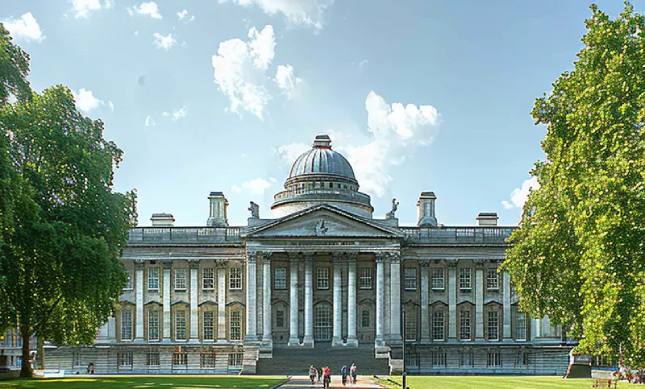
London is home to some internationally renowned Universities, including UCL.
University-level education has been taught in London for a very long time.
The oldest university in London is University College London (UCL), founded in 1826.
Established as a secular alternative to the religious universities of Oxford and Cambridge, it was the first university in England to admit students regardless of their religion, gender, or social class.
Today, the capital is home to around 40 universities attracting students from every corner of the world.
Renowned institutions such as University College London (UCL) and King’s College London are highly sought after, offering prestigious programs in various disciplines.
However, London also hosts a variety of other universities catering to diverse academic interests and career goals.
From the engineering and natural sciences expertise at Imperial College London to the social sciences leadership at the London School of Economics, there’s something for everyone.
The University of the Arts London is perfect for those pursuing creative fields, with top-notch art, design, and fashion programs.
London’s universities are known for their extensive course offerings, innovative research, and vibrant student life.
London’s universities provide numerous extracurricular activities, student societies, and networking opportunities, ensuring a holistic and engaging educational experience.
The city’s strategic location also offers students unparalleled opportunities for internships, research projects, and industry connections.
For a comprehensive list of London’s best universities and to help you find the perfect institution for your studies, check out the Times Higher Education.
This resource offers detailed information and guidance to assist you in making an informed decision about your academic future.
Language Diversity in London
London is the most linguistically diverse city in the world, with over 250 languages spoken!
While English is the primary language, you’ll hear many others, reflecting the city’s rich cultural mosaic.
Bengali is the second most spoken language, with around 71,000 residents fluent in it, and Polish is third with around 45,585 speakers.
This diversity means you’ll encounter a variety of cultures and communities, ensuring you can find someone to converse with, no matter your native tongue.
London also has unique dialects, including the famous Cockney rhyming slang. Although it’s not as common today, hearing it can be an intriguing part of your London experience.
The linguistic richness of England’s capital contributes to a vibrant, multicultural atmosphere that defines living in London.
For more on London’s linguistic diversity, visit London’s Language Map.
International Travel
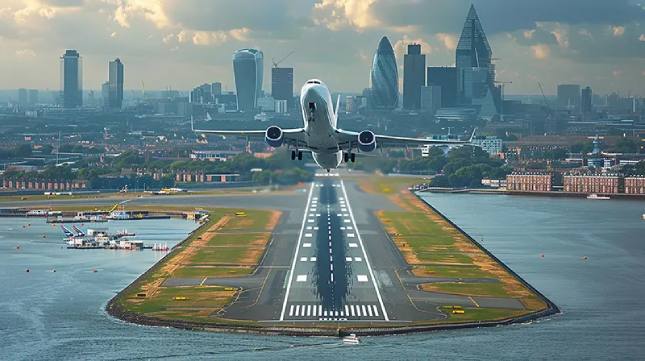
London’s various airports allow for easy travel across the globe.
With so many languages spoken in the capital, it may come as no surprise that international travel is incredibly convenient meaning living in London is a dream for travel enthusiasts.
The city boasts six major airports: London City, London Gatwick, London Heathrow, London Luton, London Stansted, and London Southend.
These airports offer easy access to international destinations, including Canada and the USA, plus direct flights to thousands of European destinations.
The Heathrow and Gatwick Express train services make getting to and from these airports seamless, enhancing the convenience for frequent travellers.
London’s status as a global city ensures residents enjoy diverse travel opportunities, making it the perfect base for exploring the world.
The Tube
One of the most intimidating aspects of moving to the capital may be the often confusing underground train network.
Known locally as the Tube, the London Underground is actually one if the easiest ways to navigate the city, although it may take a little getting used to!
This extensive network spans the entire city even reaching some of the suburbs and helps over a billion passengers traverse the capital each year!
With eleven lines, including the Victoria, Piccadilly, Central, Northern, Circle, District, Bakerloo, Jubilee, Metropolitan, Hammersmith & City, and Waterloo & City lines, the Tube is an essential part of daily life in London.
Using the Tube requires a contactless or Oyster card, ApplePay or contactless bank card, which makes travel simple and efficient.
Whether commuting to work or exploring the city’s attractions, the Tube is a reliable and convenient mode of transportation.
Do keep in mind that the tube can get very busy during peak hours, so it may be best to plan your trip around the busier rush hours!
For more details on the Tube, visit Transport for London.
London Buses
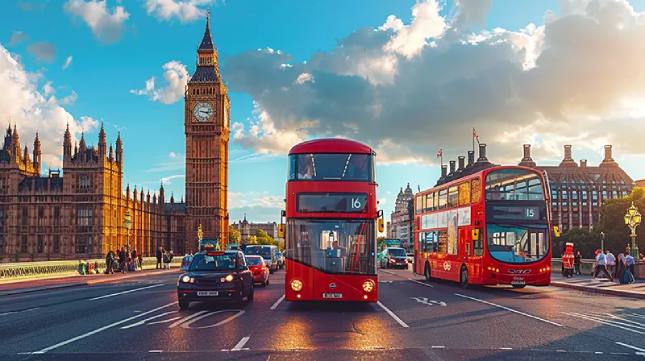
The iconic red London buses are a great way to get around the city.
The red London bus is instantly recognisable and is as iconic today as it has ever been.
If you are moving to London without ever having visited you might be shocked at just how many of these iconic buses there are!
Buses aren’t just a pretty feature of London’s streets, they are actually another excellent way of navigating the city.
Once again, travelling in buses has gone completely cash-free, so you will need an Oyster Card of some form of contactless payment.
Travelling by bus is the cheapest way of getting around in London, with a single journey currently costing £1.50.
Bus routes cover the whole of the city, which while convenient also means they can be very confusing so be sure to plan your route before simply hopping on a bus!
Apps like Google Maps have some really convenient travel tools, including bus routes, so it shouldn’t be too tricky to plan your journey.
London Black Cabs
Another staple sight on London streets is the black cab.
These taxis operate throughout the capital and can come in really handy when other transportation is unavailable.
Much like London buses, the black cab is synonymous with London and can be found literally everywhere.
Cabs tend to be on the premium price side.
A meter will run throughout your journey, so if there is significant traffic hopping out could save you a pretty penny!
Black cabs are the only taxi service that is licensed to pick passengers up from the side of the road.
Whilst other taxi services such as Uber are available, a black cab is certainly a must-have experience.
Ready to Start Living in London?
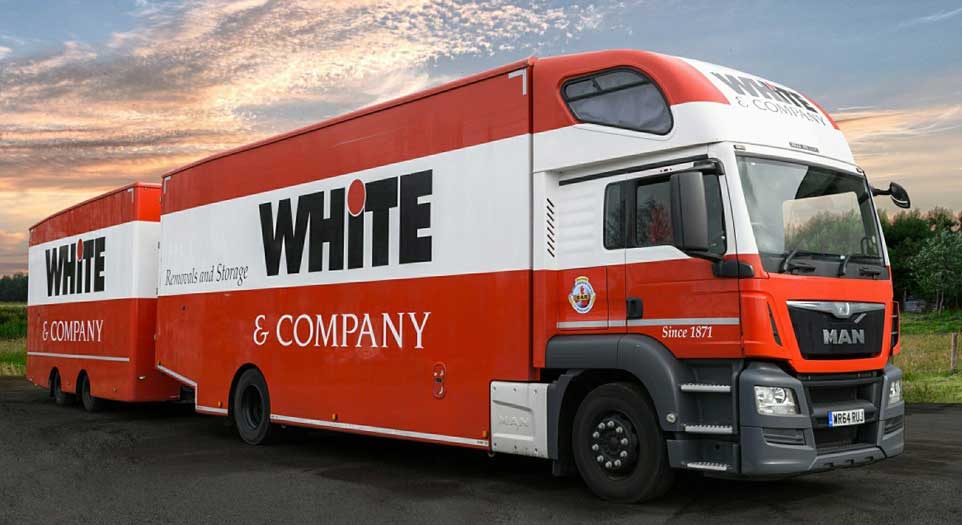 Are you considering living in London?
Are you considering living in London?
England’s diverse and exciting capital city is a truly unique place to live and offers something for everyone.
Providing a range of excellent activities for families, outstanding education for students and an atmosphere like no other, London might just be the perfect city to call home.
If you are looking forward to moving to London, you’ll need to start planning the logistics of moving your belongings to the capital.
You can start planning your dream move with the assistance of our London House Removals service from White & Company today.
Do not hesitate to give us a call or fill out a quick quote form to see how we can get your move to London underway today.

Max is a seasoned writer and blogger in the real estate and home moving sectors, as well as a knowledgeable source of information for expatriates living and working abroad. His detailed insights have helped thousands of people move and live abroad with greater simplicity and ease.
Posted in: News
Leave a Comment (0) ↓


